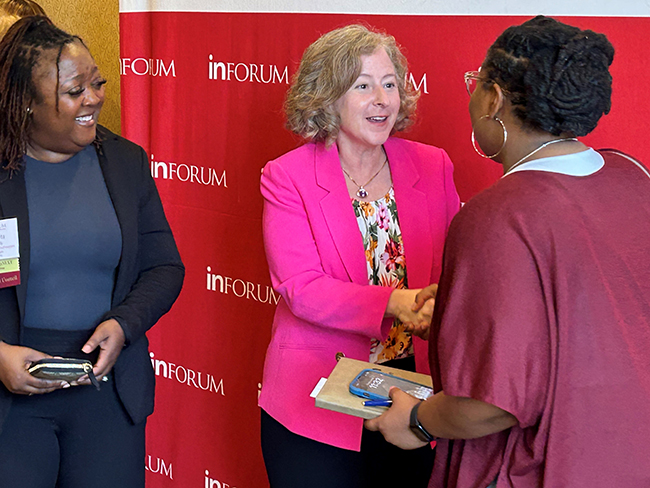
Carlos Cubia believes that, for years, the stories of contributions of women to the fabric of the nation haven’t seen enough light.

Cubia, speaking at Inforum Michigan’s 62nd annual meeting, themed “Becoming Visible: The Importance of Women’s Stories,” said it’s “particularly important that women’s stories come to the forefront.”
“Historical narratives have often minimized the perspective of women and restricted their agency,” said Cubia, the chief inclusion, equity, diversity and sustainability officer for Corewell Health and a member of Inforum’s board. “So often women have been overlooked, undervalued, misrepresented and have not had a voice. I see the value of giving women a voice, uplifting women, being a mentor and a champion for women.”
Inforum Michigan is a nonprofit organization that encourages and supports women’s leadership in the state. Cubia was speaking to the nearly 500 attendees gathered at the Troy Marriott last week. There was also an audience watching at Steelcase in Grand Rapids and a virtual audience.
The meeting featured keynote speaker Elizabeth Babcock, the founding director of the Smithsonian American Women’s History Museum in Wasington, D.C.
Bringing stories of women to the forefront, as Cubia suggested, is Babcock’s goal as she gets the museum, approved in legislation in 2020, off the ground.
She pointed out the museum has formed an advisory council, hired two dozen staffers – “We’re open for business!” she said – and found a desired site for the brick-and-mortar museum. The project, she said, is expected to take “about 10 years.”
“We want to create a museum about women, for women — and men — for us to celebrate together all the many ways women have contributed to American history,” Babcock said. “Throughout history, women have worked together. We’ve overcome societal challenges, economic challenges, personal challenges … I like to think of women as change-makers. From its earliest days, (Inforum) understood that in order (for women) to advance in business, they had to work together.
“Back in the 1960s women were not in the room … not allowed to be part of some of the business networkjng or professional associations. We’re in the room now,” she added.
Terry Barclay, Inforum’s president and CEO and a member of the Michigan contingent working to make the museum a reality, said the museum’s mission is to “create space for women’s history on the national mall in Washington D.C.

“But it’s also to deepen our nation’s stories and inspire conversation, connection and change,” Barclay said. “It’s also working to expand the story of America, through often-untold accounts of accomplishments of women, individually and collectively, to better understand our past and inspire our future.”
The Smithsonian has been around 175 years, but has not included a facility dedicated to women among its 21 museums and nine research centers around the world.
When she was appointed June 3, Babcock shared the news with friends, colleagues and family, most of which reacted with surprise.
“They said, ‘wait, what?” Babcock recalled with a smile. “’There’s not already a museum about women?’
“The mission of the Smithsonian is to advance knowledge and to share that knowledge and inspire people, not only about the past, but about the future,” Babcock said. “This (women’s) museum we’re going to build is going to be part of that articulation of what is the future for women, for all of us together.”
And, if Babcock’s research is any indication, the museum is needed.
“The few stories about women that you find are not representative of the work and impact we’re having,” she said.
For instance, she said, on Wikipedia:
- Less than 20% of biographies are abut women
To combat that, the museum has volunteers do “Wikipedia-athons” to edit Wikipedia pages.
- Only 11% of the stories in U.S. history books are about women.
- Only 10% of public monuments across the U.S. are of women. “And a huge percentage of those are mermaids,” she said, drawing a big laugh.
“That’s an example of why this museum is important,” she said.
The stories the museum plans to share, she said, are “ones about how women have … affected change, collectively and together.
“Our museum is going to be your platform for showing how women are affecting change,” she said.
People do not have to wait for the museum to open before they submit such stories. Cubia, for instance, told a story about how his mother inspires him. Such stories can be submitted here.
“When you tell your story you share a little bit of yourself with the world … you become vulnerable,” Cubia said. “Sometimes doing so comes with great risk. But yet there are some stories that must be told because they educate, they inspire and they even heal.”





